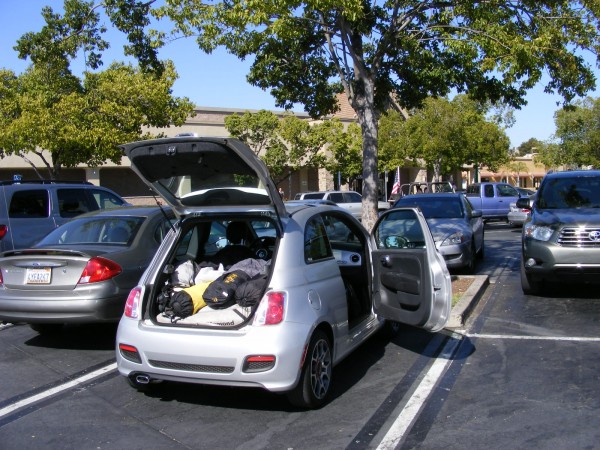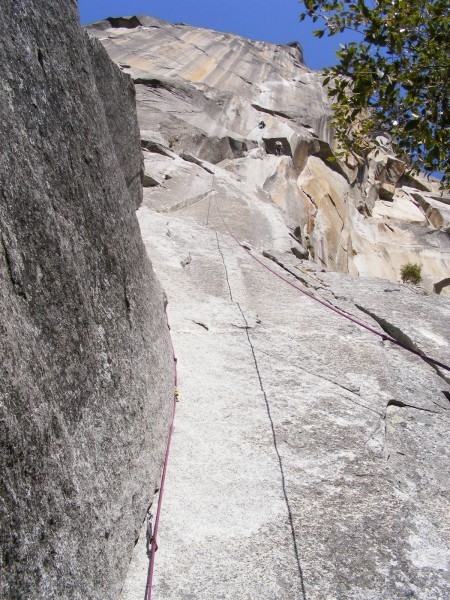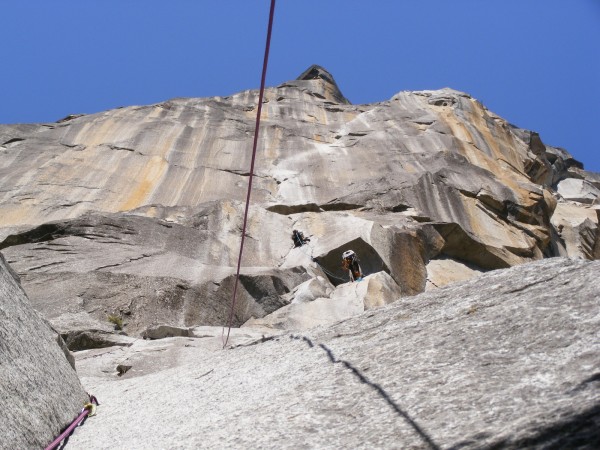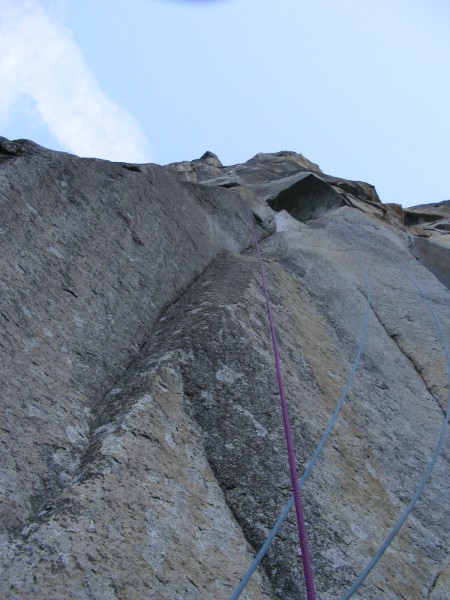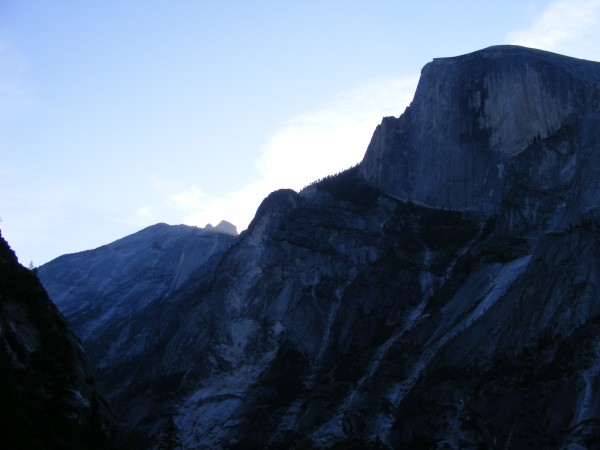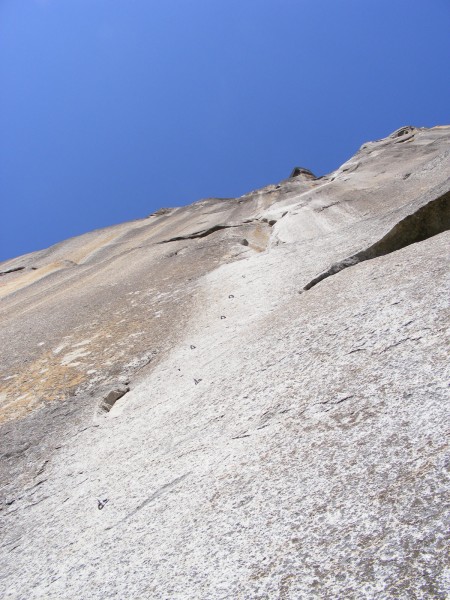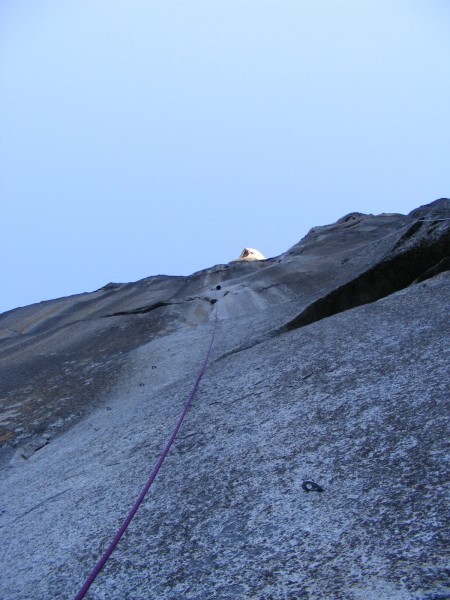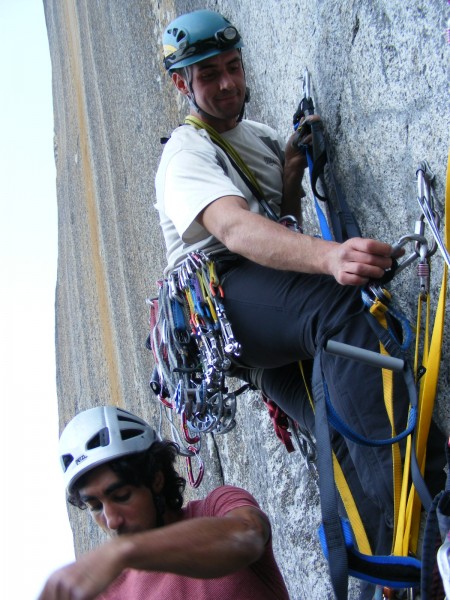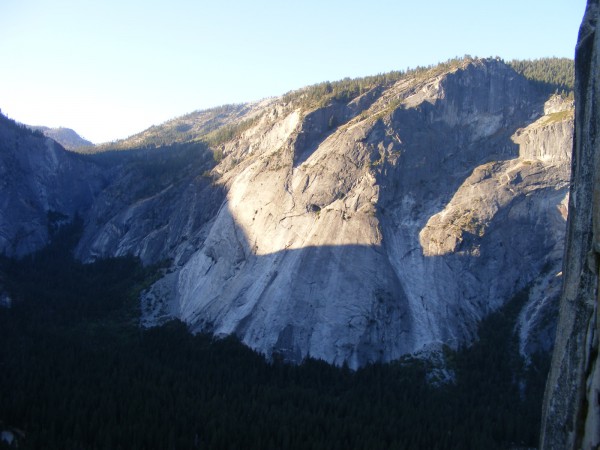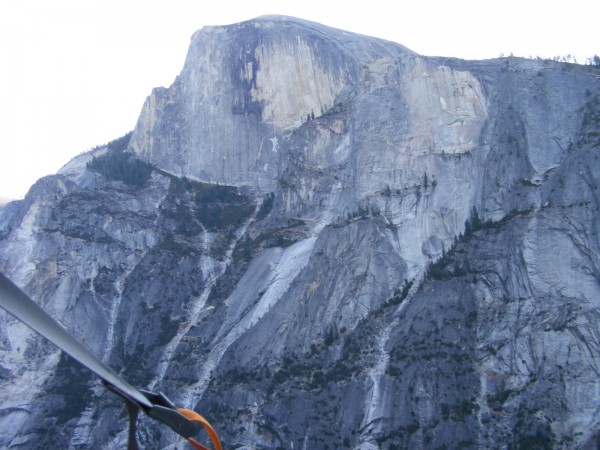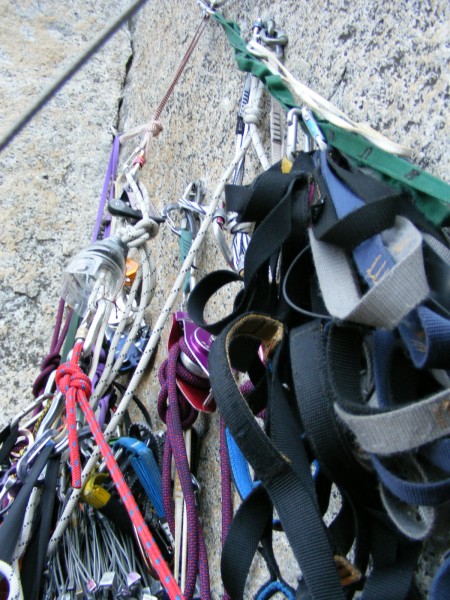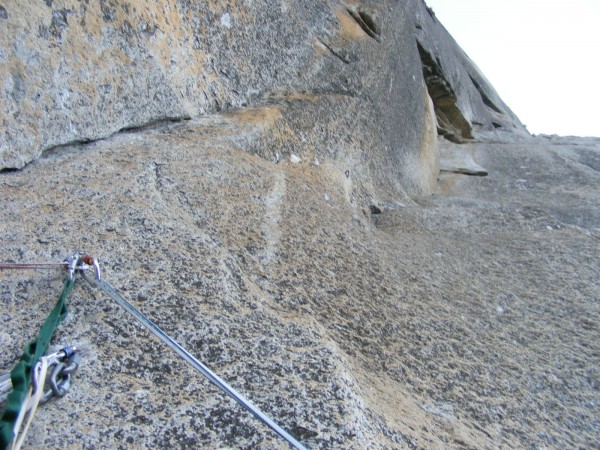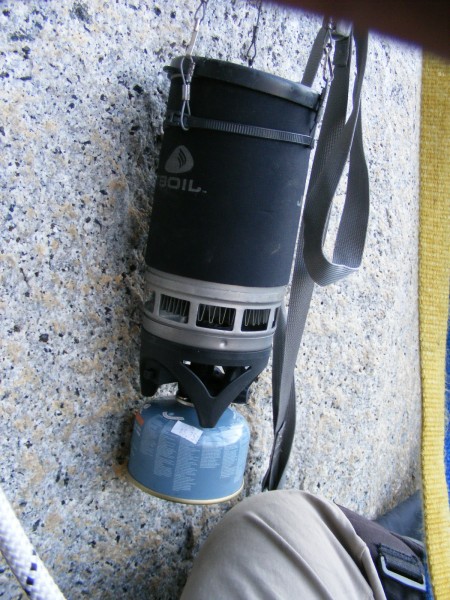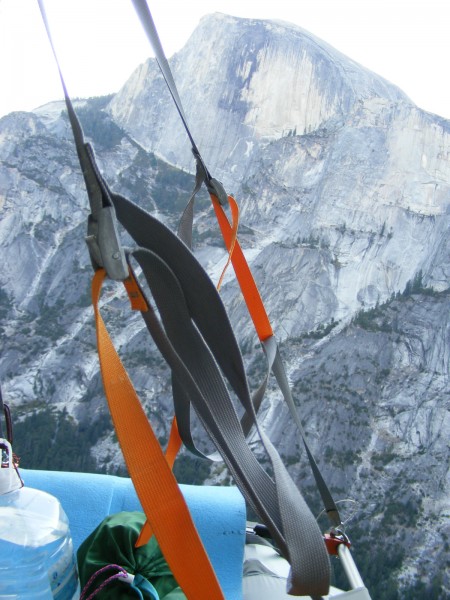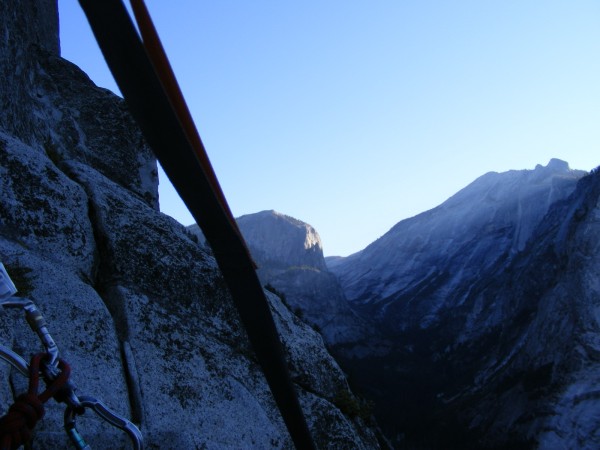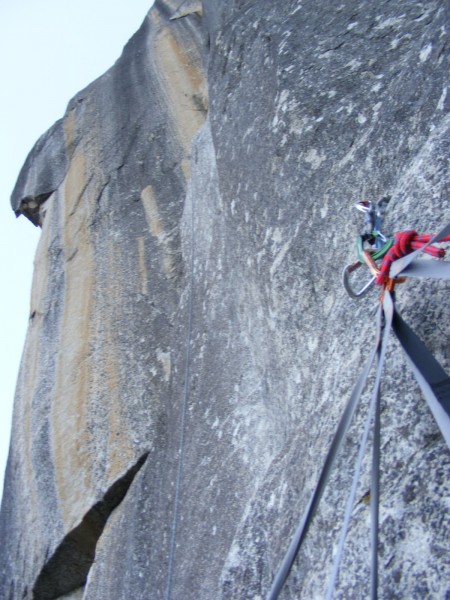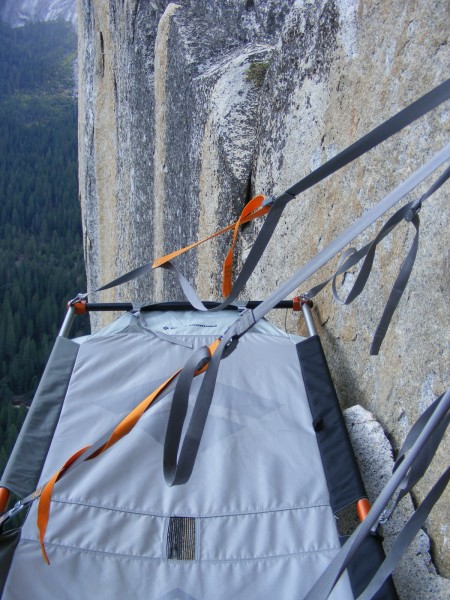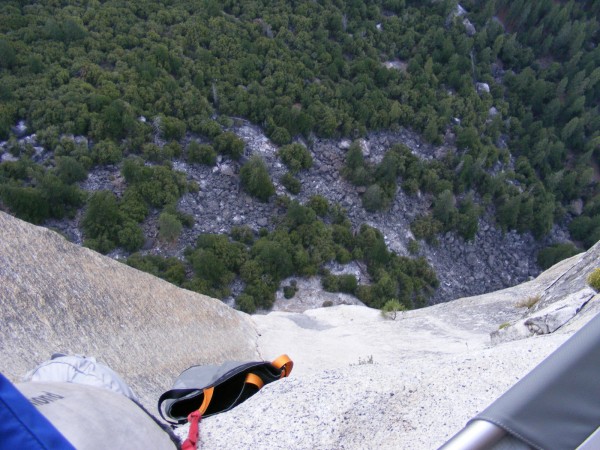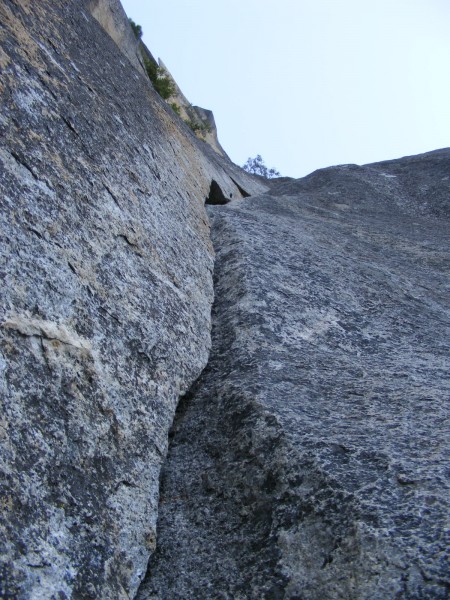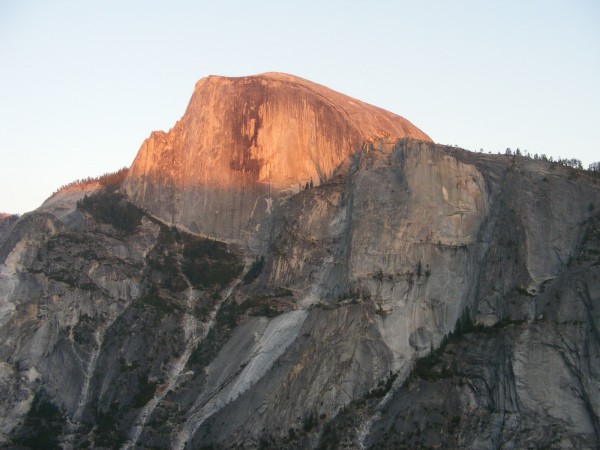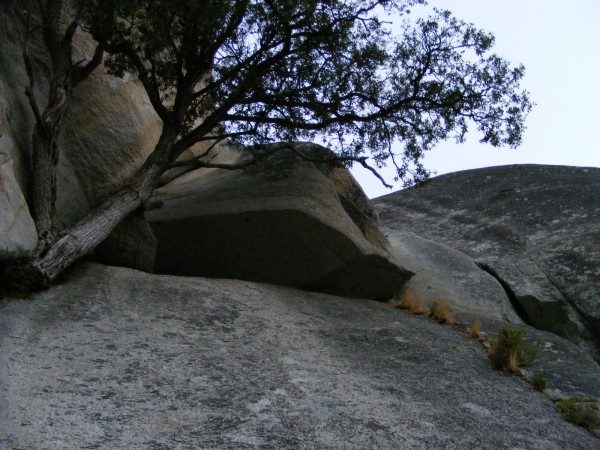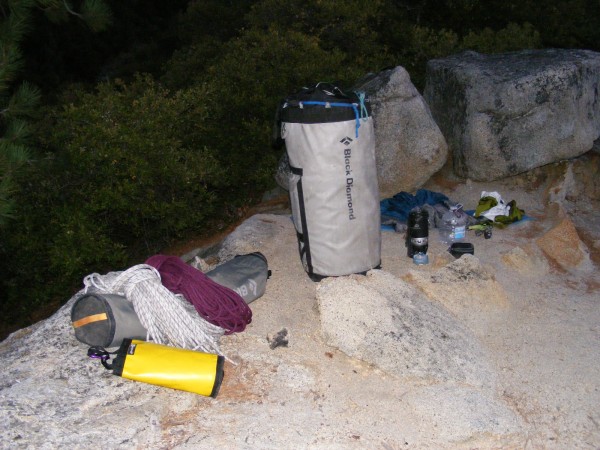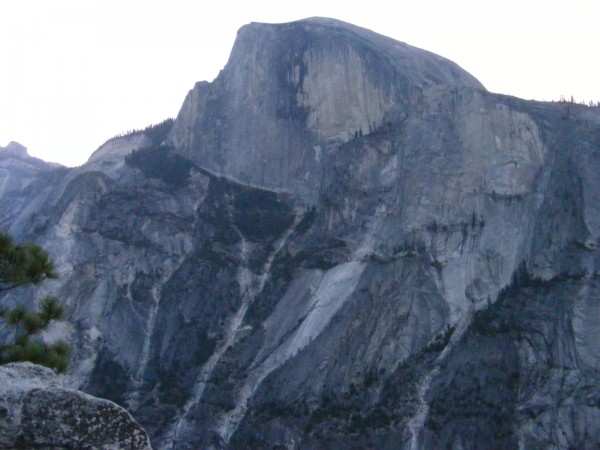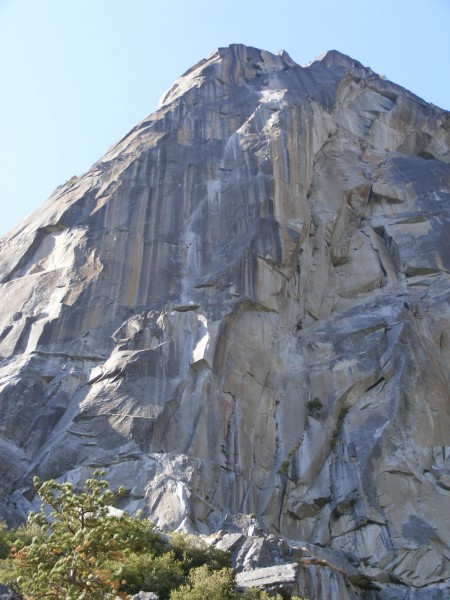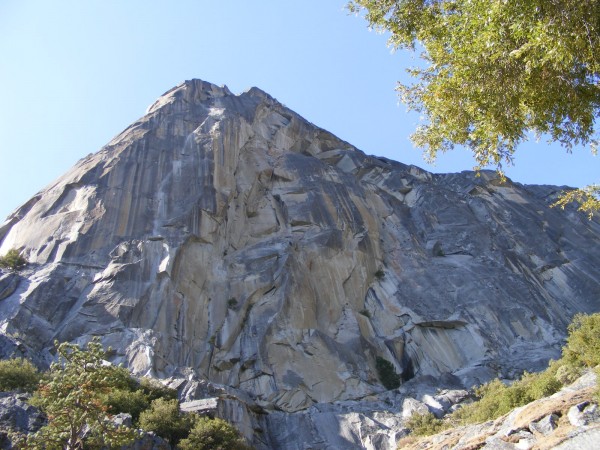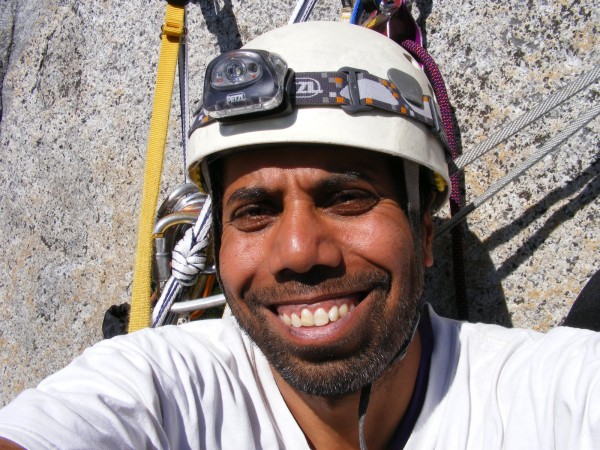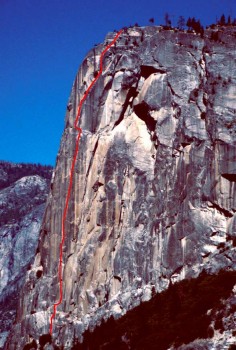The Dialogue
The crux of the Prow is not on the climb itself. It occurs during the walk-off descent, the traverse from the top of Washington Column to the start of the North Dome Gully. I was on some type of incipient path, not completely lost but not on the correct trail, scared, tired, mentally drained, and weighed down by the load of gear on my back and harness.
''Watch your step here, bro,'' he said to me, like a guardian angel shepherding me to safety. I felt Joe's presence throughout the descent and maintained a constant conversation with him at all the slippery, sandy cruxes -- where a single slip could send me for a long ride down the East face of Washington Column, a one way ticket to a meeting with my Maker.
''I made it through this section, Joe,'' I would say after a crux section, and his typically blunt reply came through loud and clear: ''Yeah, but you suck at these descents, bro. Learn to walk before you climb, bro, and be careful here.''
And so it went -- for the entire descent an internal mental dialogue between Joe and me sustained and carried me step by step to safety. Five hours later, after much ungraceful butt-sliding and fearful downclimbing in the North Dome Gully, I emerged into the safety of the woods and the straighforward trail back to the Ahwahnee hotel parking lot.
Background
I had never managed an honest Yosemite wall ascent. I had been fortunate to ride the shoulders of better climbers for a few ascents in Yosemite (on Leaning Tower, the Prow, Tangerine Trip and Zodiac), but I've always had the feeling of not having legitimately climbed the route even when I made it to the top. I've assisted and participated in the ascents, allowing my stronger partners to do most of the leading while I often sat and belayed, feeling moderately uncomfortable and scared by the exposure, never fully adjusting to the rhythms and flow of a true wall ascent. I would show up to Yosemite with delusional plans of climbing some wall on my own, get scared and intimidated on the first pitch, and then chicken out. I would then head to the Camp 4 bulletin board with my tail between my legs and beg for a partner. Luckily, I've almost always succeeded in finding partners, and they have always been much better, much stronger, and more experienced than me.
In fact, one of the advantages of being an untalented, low-quality, climbing poser (myself) is that it is easy to find good partners -- anyone reasonably competent is going to be better and faster than me. Another advantage of being a ``bottom of the barrel'' climber is that it is easy to challenge myself -- challenge does not require something long or serious on El Cap. An introductory trade route on a smaller formation (like Washington Column) is more than sufficient to bring me to my knees and make me cry for my mama. The outcome is far from guaranteed, and probability of failure is quite high.
For 2012, I decided to make a good, hard, honest attempt at the Prow. The difference between 2012 and earlier attempts is that I was now firmly grounded with a solid knowledge of the extent of my incompetence. Grandiose plans were replaced by modest hopes of simply slogging and enduring my way to the top -- not by speed and talent, but by careful planning, preparation on smaller cliffs, patience and persistence.
Travel Day
After a long but uneventful flight from Albany, NY to San Jose, I rented a car and drove to the valley.
I stopped to buy groceries, a gas canister for my stove and stopped for dinner at the Priest Station Cafe. I met and was served by Denise Anker (sister of Conrad Anker), who was very friendly and told me about the history of the cafe, a bit about Conrad's Meru trip, and generally made me feel at home. I bought some chocolate covered cherries there (for half the price of the same thing at Yosemite village). I stopped to sleep for a few hours just before entering the Yosemite valley park entrance. I slept in seated position in the driver's seat of the car for a few hours, then drove into the valley feeling rather tired.
Day 0: Load 1
The next morning was spent securing a campsite in Camp 4, and trying to relax/unwind from the East coast state of mind. I carried a load (consisting of the lead line and rack) to the base of the Prow that afternoon, hoping to fix a pitch. It turned out that there was a party of two on the first pitch, so I decided take my place in line and come back the next day. I felt rather tired from the travel and lack of sleep and was glad to postpone the start by a day.
Day 1: Pitch 1
The next day I carried a second load to the base and saw that the previous day's team was bailing from the Prow and switching to the South Face. I waited for the cliff to go into the shade (around 2 pm) before starting the first lead. A free climbing party showed up to do JoJo, so I did the conventional start in the corner to the right of JoJo. I think JoJo is a much better way to start the route, and I'd recommend this to future parties. I was fairly slow in leading the 150 foot long pitch, but finished before dark, rappelled to the base, and decided to clean the pitch and continue the next day. The decision to postpone cleaning the pitch was a mistake.
Day 2: Pitch 2
The next day I made a rather late start, and by the time I showed up to the base with the third gear load, I saw that another party of two had jumped ahead of me. This did not concern me as much as the fact that I was monopolizing the first pitch and had prevented them from doing it, since my gear was still sitting on pitch 1. It turned out that this party was simply ''aid cragging'' on pitches 2 and 3, and were not planning a full ascent. I apologized for my gear on pitch 1, and they were very friendly, accommodating and encouraging. They didn't mind my occupation of pitch 1, and simply rappelled down after pitch 3 and left.
I first cleaned pitch 1. One of my nut placements got stuck fairly low on the first pitch, and I had to rappel to the ground and retrieve the hammer to tap it out. This was the only use I made of the hammer (except for crushing empty fruit cans later on the ascent).
After cleaning pitch 1, I fixed the haul line on pitch 1. I had hoped to link pitches 2 and 3 into a single pitch. However it was rather late when I started pitch 2, and I wanted to attend the evening show of the Yosemite Facelift, so I decided to only climb pitch 2 that afternoon. The start of pitch 2 is interesting and sustained, with slick starting moves above a sloping ledge. I had no desire to fall onto the ledge, so I was extra careful. It had good pin scars for offset cams and offset nuts, and ends with a traverse left via fixed copperheads to a relatively straightforward crack and a sheltered belay under an overhang. This time I cleaned pitch 2 completely before rappelling back to the ground.
Day 3: Pitch 3
The next day I carried the last load (all the food and some water) to the base. I had heard from another party that there was a hungry mouse at the base, so I was a bit stressed about leaving food in the haulbag at the base. I packed up the haul bag, portaledge, etc., jugged my lines, led pitch 3, and cleaned the pitch while rappeling down (the lead line). Pitch 3 follows cracks tending up and left, and ends with some free moves to the upper left of Anchorage ledge. I now had the lead line fixed on pitches 2 and 3, and the haul line fixed on pitch 1. I was eager to get the haul bag off the ground (hopefully away from the reach of critters and animals at the base), so I hauled the first pitch. It was a rather slow haul (I used PTPP's hauling ratchet), but I was glad that the haulbag did not get stuck anywhere, and I did not have to do any far-end hauling.
Day 4: Yosemite Facelift
At this point I interrupted the ascent for a day to volunteer for the Yosemite Facelift. I told myself that it would be a rest day. I showed up in the morning and got assigned to the El Cap Meadow restoration crew. The job consisted of cutting down unwanted pine saplings in El Cap Meadow with a pair of pruners and hauling them off to a pickup truck for removal. This turned out to be more like hard manual labor in the hot sun, so it wasn't much of a rest day after all. Mercifully we ended the day early, I was able to take a shower, I was fed pizza by a delightful retired couple with whom I had worked the Facelift that day. I went to bed early to prepare for an alpine start the next day.
Day 5: Pitches 4 and 5
I was at the base at sunrise, and jugged up the haul line to my haulbag at the top of pitch 1. At this point I had the unpleasant task of hauling up to the top of pitch 3. I didn't like the idea of hanging the haulbag off a fifi hook, so I did things the painfully long and laborious way. I jugged up to the top of pitch 3 with the free end of the haul line, and fixed the haul line onto the hauling pulley for the haul. Then I rappelled down to the top of pitch 1, released the haul bag, and again jumared up to the top of pitch 3. At this point I tried a straight one-to-one haul and realized that it would work (even with the full haulbag + portaledge + fly weight), so I did a one-to-one haul for this and most of the rest of the route.
I was excited to start pitch 4 because it started with an easy bolt ladder and I thought progress would be fast. It turned out that the section after the initial bolt ladder was quite laborious. I consumed a fair amount of gear on this section, so I did not link pitches 4 and 5, as I had hoped to do (my lead line was 80 m). So I rappelled and cleaned after pitch 4, but did not haul the bag and restack the ropes. I simply continued leading pitch 5 with my ropes stacked in the ropebag at Anchorage ledge, knowing that I had more than enough rope with my 80 m lead line.
At this point it was late in the day, and my objective was simply to get to the pitch 5 bolt ladder section before sunset. I did get to the bolts before dark, but found the reaches quite long (I'm 5 feet 9 inches). Since every bolt required some high stepping, it was a rather laborious process. Since the pitch also moves diagonally (to the right), I couldn't backclean the bolts as I usually prefer to do. Ultimately there were 3 moves on this pitch where I used a short cheat stick, including a section requiring the stick on consecutive bolts. I was concerned about unweighting the cheat stick from the lower bolt (for redeployment for the next bolt), and managed this by topstepping the bolt below the lower bolt, only using the cheat stick carabiner for balance, so I could unweight it. On pitches 4 and 5, I used Mark Hudon's tutorial for the continuous loop method with the slippery knot and a light tag bag (containing a bottle of water, a snack, and the pee bottle). I left the tag bag at the belay station at the end of pitch 4, a mistake I later regretted.
Since it was quite late (and dark) when I finished leading pitch 5, I rappelled from the belay station at the end of pitch 5 all the way to Anchorage ledge (pitch 3), and set up my portaledge at Anchorage ledge. By this point I had established a routine of making a single phone call to my wife/daughter in the evening at the end of the day's climbing. In normal life I do not own a cell phone, but I bought a cheap AT&T cell phone plan, specifically for the wall. That day's phone call happened rather late, and it was midnight by the time I set up the portaledge and finally collapsed.
Day 6: Pitch 6
The next morning I was treated to a fantastic feeling of spaciousness and air, with the early morning view of Half Dome and the generally picturesque wall bivvy situation.
I wanted to linger in bed and relax, but I could hear voices below me. I thought the voices were from the South face, since I couldn't see anyone on the lower pitches of the Prow. I took a leak (without my pee bottle, which was in the tag bag at the pitch 4 anchor). Shortly thereafter I heard complaints from below, and a climber emerged from under the roof guarding the belay of pitch 2 of the Prow. I had accidentally watered the party below me, and now they were racing up to Anchorage ledge, where I was bivvied. I apologized profusely, and
observed that they were moving super fast. By the time I had performed my morning rituals and eaten breakfast, the leader was next to me at the belay. Inspite of the awkward situation of getting unwantingly baptized by my fluid release, he was super cool and friendly. It turned out that they were a PIAD (Prow In A Day) party, so I told them to do whatever it took to pass me. While Vitaly led pitch 4, I had a pleasant conversation with Hamik, (a computer science graduate student at Caltech) about mathematical computer science, Riemannian geometry, string theory and other random topics that make good wall conversation. (I am a mathematician by profession, so I enjoy the company of appropriate geeks).
Vitaly and Hamik finished passing me at the end of pitch 5. I cleaned pitch 5 and did a combined haul of pitches 4 and 5. The mechanics of letting the PIAD team pass and doing the combined haul consumed a fair amount of time. It was early afternoon when I had the ropes stacked and was ready to lead pitch 6. I expected an interesting and sustained engagement with pitch 6, and it did not disappoint. It is mostly a good C2 crack with a bolt once in a while connecting features. There was a semi-free long move on a sketchy copperhead towards the top of the pitch, but nothing really too hard. However, the pitch is a fairly sustained 130 foot pitch, probably one of the better pitches on the route. For the most part I found the copperheads on the Prow to be of excellent quality (not old, not rusted, some very new, some as good as bomber nuts in a constricted slot). On pitch 6 I used the continuous loop method, with a slippery knot, but I was extremely concerned about the rope self feeding all the way to the slippery knot. Perhaps the solution is to have several slippery knots on separate carabiners in series, this is not something I have tried out. By the time I had pitch 6 cleaned and hauled it was quite late that night. I set up the portaledge at the pitch 6 anchor by connecting a long sling from the main anchor to a rivet and bolt way off to the right. It was not as good a bivvy spot as pitch 5 would have been, but it worked adequately for me. The process of setting up the portaledge from the hanging belay, with my headlamp -- this was not pleasant or easy. After finally eating dinner, I went to bed at 1 am that night.
Day 7: Pitches 7 and 8
My objective for the day was to climb the next two pitches and set up the next bivvy on Tapir Terrace. After the late night the previous day, I made a slow start on pitch 7, the Strange dihedral.
Pitch 7 was not too bad, and I linked it with pitch 8. The arrow on the topo for pitch 8 (suggesting a pendulum) is really a traverse -- I placed a cam high in the crack, lowered myself with a grigri till I could carefully traverse right with my feet on a decent ledge. This led to a C2 crack with a bunch of fixed gear. The unpleasant part of this pitch is that this C2 crack goes quite a bit to the right and then curves back left. It turned out to be okay for me because (i) I did not need to worry about rope drag, and (ii) I cleaned this entire section while rappelling pitch 8 and straightened out the rope before jumaring and cleaning.
On pitch 8 I took my only fall on the entire route. I placed a hook on a horizontal in an attempt to gain height for a long reach to a bolt (at the end of the C2 crack). The hook skated off and I landed up taking a short daisy fall onto the lower piece. I use Metolious adjustable daisies that are officially rated for only 300 pounds. The daisy chain was fine, and I was fine. I'm reporting this in case any others are weighing the pros and cons of using Metolius adjustable daisies. Of course, you cannot blame me if you die using (or misusing) Metolious adjustable daisies, I'm not responsible for what anyone else does. I'm simply reporting the fact that I took a daisy fall onto a Metolius daisy, and both the daisy and I were just fine. I then bypassed the hook move by highstepping, using the horizontal as a handhold and for balance.
Towards the end of the pitch I got lost and did a fair bit of wandering on the free climbing section on the right side of Tapir terrace. I saw some bolts high off to the right and climbed up to them. Then I realized that the belay bolts for the next pitch were much lower and to the left. There was a bail biner on the incorrect anchors, and I lowered and free climbed down from this bail biner, using the grigri as a backup device. These maneuvers cost me a fair amount of time and extra rope, so I was glad that I had the extra long 80 meter
lead line. After reaching the correct belay point, I was able to untie from the lead line, disconnect the haul line from the lead line (I was using the continuous loop method, thanks to Mark Hudon), and pull the free end of the lead line through the bail biner on the incorrect anchor.
At this point another party had showed up at the pitch 6 belay anchor, so I was anxious to rappel down immediately to clean pitches 7 and 8. It turned out to be a Spanish team, Luis and Javier, from Catalan. They were very friendly and didn't seem to be in any kind of hurry, even though I was very stressed about being in their way and slowing them down. They just smoked a few cigarettes that they rolled themselves, shot the breeze with me, and calmed my nerves. They wanted to give me space, and they waited patiently for me to clean before
starting to lead the Strange dihedral (pitch 7). It turned out that the Catalan leader, Luis, was super fast and joined me at the Tapir terrace belay in a jiffy. The belay is very spacious, so we were able to share the belay on separate bolts, and arrange for them to pass me. But they were in no great hurry, and paused at Tapir terrace to have a smoke, share some cookies with me, and talk about this great cliff in Spain called Riglos.
Just before sunset Luis decided to lead pitch 9 where they set up their portaledge (one pitch above me; I stopped at Tapir terrace). I observed Luis leading pitch 9 and noticed that part of his speed came from his ability to easily free climb in and from his aiders. He highstepped for a free move from a high step in his aiders, and skillfully reached back to retrieve his aider after the move. This ability to confidently climb 5.10 type moves in approach shoes and in transition from aid to free -- this is something I would like to work towards. It is definitely one of the differences between mediocre, chickenshitty climbers like myself, and the much better ones like Luis. He told me that his next objective was a solo of the Zodiac on El Cap, and he did just that. After I got down from the wall I saw his green portaledge just below the Nipple, and even got to see him pulling the Nipple through Tom's telescope on the bridge. Good job Luis, congratulations on the Zodiac solo.
Day 8: Pitch 9
At Tapir Terrace, I considered taking a rest day, since it was such a nice bivvy spot. Then I grew concerned that I may interfere with other parties following me, and decided to keep climbing. It turned out that no other parties showed up while I was on the upper section of the wall, so this was an unnecessary concern. I also considered the idea of linking pitches 9 and 10 (with my 80 meter lead line), but I wasn't sure if my lead line was long enough for this maneuver and scrapped the idea. Pitch 9 is a short 100 foot pitch, but it kept me on my toes. I had read an internet report of a climber taking a fall on the start of pitch 9, hitting a ledge as part of the fall, and breaking bones. This information induced me to be super careful. There were some C2 moves with carefully placed offset cams at the start, and I think this pitch merits an upgrade from C1 to C2. The moves require care, and the consequences of a fall are unpleasant (high probability of hitting a ledge). The pitch becomes steeper and easier at the top, but I put in a lot of effort and care on the first half of this pitch.
Pitch 9 ends on a small but nice ledge. The belay consists of fixed angles in a crack (which I backed up with my own gear), and there is a bolt out left which I used to hang my portaledge. I had plenty of daylight after leading, cleaning and hauling pitch 9, but I decided to stop there and relax. I did not like the idea of starting the long 170 foot pitch 10 lead towards the end of the day, with inevitable headlamp dynamics late into the night. So I set up the portaledge on pitch 9, and used the daylight to carefully rerack and restack my ropes for pitch 10. This saved me time the next day, enabling an earlier start to the climbing day.
Day 9: Pitch 10
Pitch 10 starts out with a relatively straightforward C1 or 5.10 crack that transitions into free climbing and meets a ledge, from where a crack and chimney/gully lead up further. This crack and chimney require some moderate free climbing, which can be much more pleasant with a human belayer and without the weight of the full aid rack. In situations such as these, where one has to mix some free climbing with the aid, I find the Silent Partner to be extremely valuable. It feeds rope well and allows reasonably efficient free climbing, though I am careful to plan the rest spots where I retie my backup knot.
There are a couple of fixed nuts for a gear belay high in the chimney/gully, and I had read an internet account of belaying in the chimney to avoid the haulbag eating flake lower on this pitch. Since this gully was directly above the haulbag eating flake I wasn't sure this strategy would work. I landed up traversing left to the usual belay on top of a good ledge.
At the belay station I noticed that the knot connecting the lead line and haul line was stuck in the haulbag eating flake. I was expecting hauling problems on the haulbag eating flake, so I rapped down to free the knot. Luckily it wasn't hard to free this knot. However, the haul line did indeed land up inside the haul bag eating flake, as promised by the topo. It turns out that this haul bag eating flake is actually an excellent free climbing crack of offwidth size (but with a good edge for liebacking and rest spots here and there). If this pitch were located at ground level it would probably be a classic free climb. But at its present location, high up and slightly off to the right from pitch 10 of the Prow, it is merely viewed as an obstacle to haulbag transport. So I rappelled down again, this time directly along the haulbag eating offwidth, till I was able to swing the haulbag completely out of the crack. I was psychologically prepared for a bad hauling experience on this pitch, and took the mini-traxion and hauling ratchet down on the rappel for a possible episode of far-end hauling. It turned out that after I had rappelled all the way down and pulled the haulbag out of the crack, it hung just a few feet above part of Tapir terrace, and the hauling looked relatively obstacle free. So I rejumared the rope and successfully performed my usual one-to-one hauling until the bag encountered obstacles high up in the gully. These were close enough to the belay that I was able to sort them out with relatively short rappels, and the bags were finally docked successfully at the pitch 10 belay ledge.
At this point it was late afternoon and I still had daylight left. I could see pitch 11 pulling out of the gully via an overhang that led to good cracks. I considered starting the next lead, but eventually decided to make one last bivvy and climb to the top the next day. I was at an excellent ledge, I had sufficient food and water for an extra day, and I hadn't encountered any other parties, so I just kicked back on the portaledge, relaxing and savoring the wall experience. The only unpleasant part of this bivvy is that there are some critters hiding out in the cracks there, and I was afraid they would chew into my food bags. So I hung my food bags up high on the portaledge, but the next morning I noticed that they had still gotten in, chewed part of one of the food bags and attemped to get to those delicious chocolate cherries from Denise Anker at the Priest Station Cafe.
Day 10: Pitches 11 and 12
I linked pitches 11 and 12. The start of pitch 11 involves some free climbing up some overhangs (with good gear) until a bolt next to a wide crack. I was fully prepared to do wide crack battle with number 4 and number 5 camalots, but this wasn't necessary. At this point I had the option of two cracks. The closer (left side) crack became wide and would have accepted the big camalots. The other (right side) crack is an excellent splitter taking red and gold camalots, so I chose this crack. It ends up moving back to the left crack after a bit, and the crack finally transitions to a broken, ledgy section of easy free climbing. At this point, I thought I would unload the weight of the heavy number 4 and 5 camalots, and I hung them off a piece. As I continued up and right, I observed that I would have to make an awkward free move up a small overhang above a slab. I also noticed that the best protection for this move would be a big cam, so I climbed back down to retrieve the big camalots. I placed the number 4 camalot for protection, shouldered the number 5 camalot and made the free moves to reach the belay bolts for the end of pitch 11.
Since I was linking pitches 11 and 12 I continued on diagonalling right till I reached a bolt above a small overhang. At this point I could smell the summit, with easy third and fourth class scrambling immediately to my right. Above the bolt, I still had to make one more placement before I could ease into the scrambling. I made free moves up a corner and diagonalled right till I reached a fat tree with slings, but I did not like the diagonal path of the ropes. So I traversed back left on some loose and sandy ledges till a final, small overhang which deposited me at a pair of trees that constitutes the real pitch 12 belay tree.
On this pitch, I did not use the continuous loop method (because I was concerned about the knot connecting the lead line and haul line getting caught in a crack) and simply trailed the haul line on my harness. At this point, the movement back and forth resulted in the ropes getting caught behind some shrubs and corners. This wasn't much of an issue for the lead line, since it does not generate rope drag, but I had hideous rope drag from the haul line. I rappelled down, straightened both lead line and haul line from the obstacles, jumared back up to the pitch 12 belay trees and fixed the lead line for the clean and the haul line for the rappel.
For most parties of two (or more) climbers, reaching the final anchor is basically the end of the route. But for me, I was still faced with a fair amount of work. I first rappelled and cleaned the pitch (the easy part). Then I rappelled again on the lead line with the far end hauling kit. I performed far end hauling till I got the bag out of the chimneys. I thought I could continue far end hauling, but felt that it was taking too much time. So I jumared back to the top and performed one-to-one hauling (on the Kong roll block) until the bag got stuck on the final lip before the slabs of pitch 12. I rappelled to the bag, freed it from the lip, jumared back to the anchor and continued one-to-one hauling. The bag did get hung up on the last few slabby lip obstacles, but these were close to the anchor, so I was able to do short raps to free the bag.
By the time I had the bag at the anchor, it was almost dark. I heaved a sigh of relief and sat down to take a break. I then noticed that the anchor area was infested with ants -- big, unfriendly red ants. So I moved all the kit to a nearby flat bivvy spot, and finally relaxed to make my customary phone call to Natasha, telling her I was on top.
I was still quite stressed about the descent, and decided that I needed to organize the rack and the gear that night in order to prepare for the next day's descent. This was time consuming, but not difficult. I ate dinner, and worried about whether critters would get to the slim leftovers of my food. So I buried the food deep inside the haulbag, piled the metal hardware and ropes on top, and went to sleep. I slept lightly, much worse than the portaledge bivvies on the wall.
Day 11: Descent with Load 1
I woke up early to a beautiful sunrise, after a light and restless sleep. My food was untouched by critters, and I ate breakfast from the leftover food. At this point I had a gallon of water left. I used some for a morning coffee and filled up a water bottle for the descent. I had decided to go down with a single load, consisting of a rope, my wall harness and various things that I could attach to it. I took the waste case with me on this load. I did not want to leave any leftover food on the summit, and didn't have a convenient way to carry it down, so I stuffed it into the top of the waste case. I reasoned that the waste was sealed, and so was the food, so it shouldn't really matter (besides the smell and some unpleasant associations).
The descent via the North Dome Gully was horrendous, as expected. The crux is the traverse along the rim to get to the gully. I had a couple of intense, existential experiences during this descent, as I've described at the start of this narrative.
After the descent, I went to the Curry village mountain shop to enquire if there was possibly a way to the tourist trail on North Dome or some other way to get my loads down. I quickly realized that I was screwed, and that the North Dome Gully was the path of least resistance. At this point I reached a spiritual low point and enquired if there may be some local climbers who would be willing to help me with the loads, for a fee. To my surprise, the answer was a qualified yes. I was given a phone number for a possible lead, and eagerly called it, hoping for the best.
Jason and I made plans to meet at the Lodge cafetaria the next morning. He suggested free-soloing the Royal Arches to get to the top, but I killed that idea. I have only climbed the Royal Arches once, several years ago. On that trip, I had used a pendulum to get past a slabby crux, high on the route -- so I hadn't even free climbed the route. I was now in a state of physical and mental exhaustion. I had ''big wall hands'' and could not close my fists. I couldn't even think of free soloing to the bathroom without soiling my bottoms.
Jason's help for descent with remaining loads
It turned out that Jason was the perfect person to help me. He had lived in the Yosemite area all his life, had grown up climbing here, and knew the place intimately. He had climbed almost all the routes on Washington Column, and made first ascents on a lot of different formations throughout the valley. Besides this, he was totally hard-core, and friendly.
We went up the North Dome Gully. I was slow and tentative, but Jason was fast and sure-footed. Jason waited for me throughout the ascent -- without me, Jason could have made it in about half the time. But he was extremely patient, as I carefully slogged up the gully. The path that Jason took was different from my path down the previous day. It certainly helped to be on the optimal path, but it also psychologically helped to be in the company of someone strong and knowledgeable (Jason).
At the top of the Column, Jason examined the remaining load and decided that he could manage it on his own, in a single trip. I insisted on carrying the portaledge and fly (which weighed nothing, compared to Jason's load). Jason was extremely fast and sure footed on the way down. I slowed him down, he was his usual patient self. At some point in the North Dome Gully proper, after seeing me struggle, Jason decided that he could relieve me of the portaledge as well. He repacked the haulbag with the portaledge inside, but I insisted on at least carrying the rope (80 meter lead line). It turned out that this was a good decision, because I used the rope to make a couple of rappels at the bottom of the North Dome Gully. Jason simply downclimbed those sections with the enormously heavy haulbag.
It was obvious to me that Jason was a hardcore superman, and I was a weakling chickensh#t. He basically rescued me and my gear from the top of the Prow and delivered me to safety. For this I will forever be grateful to him.
Epilogue
The next day I lay down in El Cap Meadow and whiled away the time. I saw Luis and his green portaledge high up on the Zodiac, and felt happy that he was succeeding in such a spectacular fashion. For the first time in two weeks, I relaxed. It was the only rest day of this ''vacation.''
Appendix
Lead line: 80 meter lead line
Haul line: 100 meter, 9 mm static line, with approx 80 meters used for hauling and the remaining cord used as lower out line.
Belay device: Silent Partner with a backup figure eight knot on a locker on my belay loop, re-tied every 30 feet or so.
Rappel device: Old style grigri for single strand rappels.
Distance led: 1310 feet (adding up the lengths of all the pitches).
Distance rappelled: 2350 feet (approximation of all the rappels over the total journey).
Distance jumared: 2370 feet (approximation of all the jumaring over the total journey).
Daisy chains: Metolious adjustable daisies. I think these daisies are stronger than the Petzl adjustable daisies (which are very similar), even though they are only rated for 300 pounds. I think the weakest point of the daisy is the very endpoint (free end with a small buckle and sewn end), and I was always careful not to load the daisy at this point (by not extending it to its longest setting). The supertopo gear review does not give a good rating to these daisies, for the explicitly stated reason that they need to be able to trust a daisy to take a fall while testing. My fall on pitch 8 was substantially similar to a jump testing fall in an aid situation, and the Metolious daisy was totally fine.
Aiders: Mostly a single pair of Misty Mountain aiders, moved from piece to piece while leading. I had a spare pair of backup aiders on the back of my harness, and used these occassionally for some rare situations involving high-stepping, traversing, or transitioning to free climbing.
Rope management: I used the Fish snake charmer rope bag, which is a double bag with enough space to fit my super long ropes.
Hauling pulley: Kong roll block. It has a large radius pulley, is super beefy, so you can do all kinds of body hauling with confidence -- knowing that the device is not going to fail/deform/break. I carried the pulley and hauling kit only while cleaning, so I did not have this extra weight with me while leading.
Hauling processes: I rappelled the haul line from a figure eight knot at each anchor, and used the PTPP hauling ratchet for the mini-haul to set up the hauling pulley at the start of each haul. Most hauling was one-to-one on the Kong roll block. For far end hauling, I used a mini-traxion on top of the haulbag, and the PTPP hauling ratchet.
Haul bag docking: I used an old style grigri (with a figure eight backup knot) instead of the Munter/Mule with overhand backup. I used the leftover segment of the haul line (about 40 feet) as the docking and lower out cord.
Rope methods: Continuous loop method with slippery knots (via Mark Hudon supertopo tutorial) for much of the route, but I also used the old fashioned method of trailing the haul line for some pitches.
Cheat stick: I duck taped a carabiner to a short twig from the forest floor (on the approach). Used 3 times on pitch 5.
Stove: Jetboil (with $10 hanging kit bought several years ago from an employee at the Curry Village Mountain Shop).
Food: Breakfast (double oatmeal packets + double hot chocolate packets + 1 bagel). Dinner (1 freeze dried dinner packet + 1 packet tuna or salmon + 1 bagel + 1 small can fruit). Snacks (Nuts/gorp, dried fruit), chocolate cherries
from the Priest Station Cafe (highly recommended).
Portaledge: Black Diamond single (+ fly). I anchored the sides and ends of the portaledge as much as I could, so as to not ''rock the boat.''
Poop tube: Metolious waste case.
Sleeping bag: Lightweight, primaloft, synthetic sleeping bag, with a specially modified zipper so I could clip my daisies and tie-in point through a zipper hole at waist level, without leaving the sleeping bag half unzipped.
Cell phone: AT&T phone, got great coverage everywhere, including the wall. The cell phone remained off,except when I turned it on to make my single evening phone call to Natasha/Sophia. The battery did not need recharging during the trip. After the trip, the cell phone got accidentally washed in the washing machine, so that's the end of the cell phone. It served it's intended purpose, and at this point it's better dead than alive anyway.
